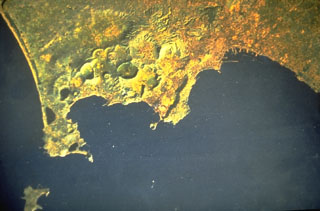Report on Campi Flegrei (Italy) — April 1984
Scientific Event Alert Network Bulletin, vol. 9, no. 4 (April 1984)
Managing Editor: Lindsay McClelland.
Campi Flegrei (Italy) Seismic energy release and uplift slow after 1 April earthquake swarm
Please cite this report as:
Global Volcanism Program, 1984. Report on Campi Flegrei (Italy) (McClelland, L., ed.). Scientific Event Alert Network Bulletin, 9:4. Smithsonian Institution. https://doi.org/10.5479/si.GVP.SEAN198404-211010
Campi Flegrei
Italy
40.827°N, 14.139°E; summit elev. 458 m
All times are local (unless otherwise noted)
"Seismic activity at Campi Flegrei decreased in April. Following the earthquake swarm of 1 April and a M 3.5 event that occurred on 3 April, the cumulative seismic strain energy release had a smaller slope than in the previous three months (figure 5).
 |
Figure 5. Daily number of earthquakes at Campi Flegrei (vertical lines) and cumulative strain release (curve), January 1983-April 1984. |
"The distribution of epicenters for the best-located events (number of stations >8, RMS
 |
Figure 6. Epicentral distribution of best-located events at Campi Flegrei through 15 January 1984. Courtesy of OV. |
"The mean velocity of uplift during April, as measured by the tide gauge located in Pozzuoli harbor, was 1.6 mm/day. This value is definitely smaller than the previous month. Temperatures of the two fumaroles within Solfatara Crater remained at constant values of 110° and 157-159°C.
"The decrease in activity observed after the swarm of 1 April is similar to the decrease observed during November 1983. In that case, a diminuition in seismic activity and a decrease in the uplift velocity were observed after a M 4.0 earthquake, and a swarm that occurred 13 October 1983."
Geological Summary. Campi Flegrei is a 13-km-wide caldera that encompasses part of Naples and extends to the south beneath the Gulf of Pozzuoli. Episodes of significant uplift and subsidence within the dominantly trachytic caldera have occurred since Roman times. The earliest known eruptive products are dated 47,000 years BP. The caldera formed following two large explosive eruptions, the massive Campanian ignimbrite about 36,000 BP, and the over 40 km3 Neapolitan Yellow Tuff (NYT) about 15,000 BP. Following eruption of the NYT a large number of eruptions originated from widely scattered subaerial and submarine vents. Most activity occurred during three intervals: 15,000-9,500, 8,600-8,200, and 4,800-3,800 BP. The latest eruption were in 1158 CE at Solfatara and activity in 1538 CE that formed the Monte Nuovo cinder cone.
Information Contacts: G. Luongo and R. Scandone, OV; F. Barberi, Univ. di Pisa.

